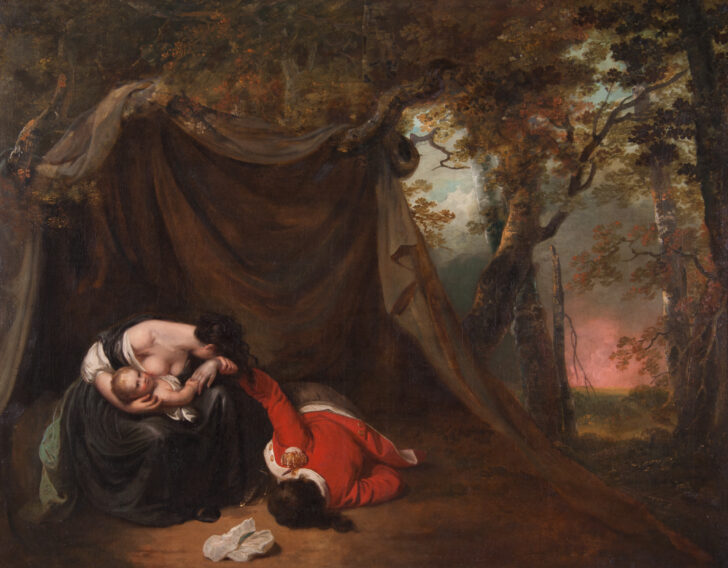The Dead Soldier
Joseph Wright of Derby

Description
March 28, 2009
Joseph Wright of Derby, a member of the industrial and creative avant garde in the north of England, first exhibited this painting at London’s Royal Academy in 1789 to great acclaim. The canvas depicts a woman cradling her child with a dramatically foreshortened cavalryman crumpled at her side. Newly widowed and destitute, the mourning woman joins the hands of the child with her own and that of her dead husband, linking their sad fates as the sun sets over the forest. That the child has fallen away from suckling at his mother’s breast suggests the poverty that awaits them both in an age when respectable women had few economic opportunities.
What was most radical about the painting in its day is that the viewer is asked to empathize deeply with an anonymous figure: we know nothing of the dead soldier’s identity other than what his uniform tells us and the hint from the date that he may have fallen in the American Revolution. It is the infant who gives us entry into the painting, looking out calmly, even sternly to meet our gaze. The emotional intensity of the painting together with Wright’s astonishing bravura brushwork place this long-lost masterpiece at a critical moment of transition in the birth of the modern age, when the rationalism of the Enlightenment began to give way to the emotion of the Romantic movement.
Subject Matter:
Inspired by a passage in the poem "The Country Justice" (1774-77) by John Langhorne, this painting depicts a grieving widow and child who left destitute by the husband's death is condemned to indigence. Wright is best known for his portrayal of Enlightenment scenes of scientific investigation and portraits. This painting was one of his most famous during his lifetime and was shown at the Royal Academy exhibition of 1789 to great acclaim. There is a smaller variant version painted by Wright in the collection of the Fine Arts Museums of San Francisco (accession number 1998.29).
Physical Description:
A fallen man in the red coat of the 18th c. British military officer lies face down in a landscape. To the left, holding his hand, is a grieving widow and infant son. Behind the grouping is a landscape that opens off to the left with the reddish glow of continued combat. Behind the figures, a drapery has been set in the trees to frame the grouping and separate it from the distant landscape behind them.
Usage Rights:
If you are interested in using an image for a publication, please visit https://umma.umich.edu/request-image/ for more information and to fill out the online Image Rights and Reproductions Request Form.